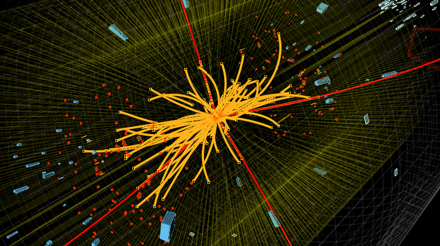The sound bite works its way backwards in time, starting with the evidence and then gradually inferring the probable cause. At the beginning you hear two distributions, one on the left and one on the right, each with 500 gamma energy values (each gamma distribution is mapped to a 500-partial filterbank); over time, each gamma distribution morphs to a distribution of Higgs masses, all 500 center frequencies converging on the single high energy/mass value mapped to the high pitch at the end. In the middle, the (static) dR and pTt distributions (also represented by 500-partial spectra controlling filterbanks) fade in and out. Over this backdrop you hear some of the explosive and shivery mappings of jet data (see below).
At the very very end, you may hear a hint of an inference of the voice of the Higgs…
Please play it as loud as your speakers can handle (it sounds best with a subwoofer if you have one). The original is in surround sound but a stereo version was easier to post.
Where did this come from?
Experimental and theoretical particle physicists Lily Asquith and Michael Krämer, in addition to their regular research and teaching duties, have been collaborating with musicians this year on a special project to take the data from some of the quadrillions of proton collisions going on in the Large Hadron Collider at CERN and mapping those data sets to sound. Not only are the researchers hoping to hear patterns in the data; they also want to share their passion for exploration and discovery with creative individuals outside of physics.
The project got started last year, when Asquith and composer Richard Dobson created the LHC Sound project, posting sounds and simulated data on the web and inviting musicians to sample the sounds and map the data. Asquith called one of the sets the Jet Game, the object of which was to be able to identify (using only your ears) which of the jets contained evidence of the Higgs boson. Carla Scaletti decided to map several of the jets to sound using Kyma, and the results ended up in the musical score she and Cristian Vogel composed for choreographer Gilles Jobin‘s Spider Galaxies.
At the beginning of this year, Asquith teamed up with Krämer and Scaletti to explore even more ways of mapping data to sound. So far, all the sounds have been generated using simulated data (the real data are top secret), but the trio look forward to having a listen to actual LHC data soon.
